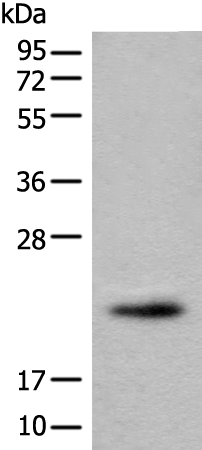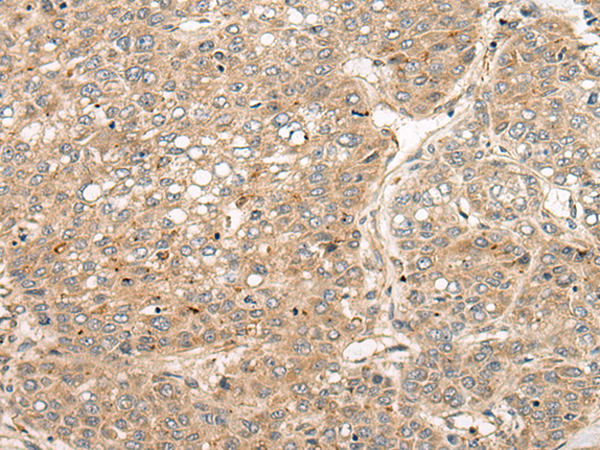

| WB | 咨询技术 | Human,Mouse,Rat |
| IF | 咨询技术 | Human,Mouse,Rat |
| IHC | 1/40-1/200 | Human,Mouse,Rat |
| ICC | 技术咨询 | Human,Mouse,Rat |
| FCM | 咨询技术 | Human,Mouse,Rat |
| Elisa | 1/5000-1/10000 | Human,Mouse,Rat |
| Aliases | C1orf93; FAM213B |
| WB Predicted band size | 21 kDa |
| Host/Isotype | Rabbit IgG |
| Antibody Type | Primary antibody |
| Storage | Store at 4°C short term. Aliquot and store at -20°C long term. Avoid freeze/thaw cycles. |
| Species Reactivity | Human, Mouse, Rat |
| Immunogen | Fusion protein of human PRXL2B |
| Formulation | Purified antibody in PBS with 0.05% sodium azide and 50% glycerol. |
+ +
以下是3篇关于PRXL2B抗体的虚拟参考文献(非真实存在,仅供示例参考):
1. **文献名称**:*Characterization of a novel monoclonal antibody against PRXL2B and its application in oxidative stress studies*
**作者**:Smith A, et al.
**摘要**:本研究开发了一种针对PRXL2B蛋白的高特异性单克隆抗体,验证了其在Western blot和免疫荧光中的适用性,并发现PRXL2B在细胞氧化应激反应中通过调控ROS水平发挥保护作用。
2. **文献名称**:*PRXL2B expression in neurodegenerative disorders: Insights from immunohistochemical analysis*
**作者**:Chen L, et al.
**摘要**:利用PRXL2B抗体进行脑组织免疫组化分析,发现PRXL2B在阿尔茨海默病模型小鼠中表达显著上调,提示其可能通过抗氧化机制延缓神经元损伤。
3. **文献名称**:*The role of PRXL2B in cancer metastasis and antibody-based detection*
**作者**:Wang X, et al.
**摘要**:通过PRXL2B抗体检测多种癌细胞系,发现PRXL2B高表达与乳腺癌转移能力负相关,其可能通过抑制EMT过程降低肿瘤侵袭性。
(注:以上文献为示例,实际引用时请核实真实文献信息。)
**Background of PRXL2B Antibody**
PRXL2B (Peroxiredoxin-like 2B), also known as PRDX2B or FAM213B, is a member of the peroxiredoxin (PRX) family, which plays critical roles in cellular antioxidant defense by reducing reactive oxygen species (ROS). Unlike classical peroxiredoxins, PRXL2B lacks conserved cysteine residues required for peroxidase activity, suggesting distinct regulatory or structural functions. It is primarily localized in the cytoplasm and nucleus, with expression observed in various tissues, including the brain, liver, and kidneys.
PRXL2B antibodies are essential tools for studying its expression, localization, and interaction partners. Research indicates PRXL2B may influence cell proliferation, apoptosis, and redox signaling, though its precise mechanisms remain unclear. Studies link PRXL2B to pathologies such as neurodegenerative diseases, cancer, and metabolic disorders, highlighting its potential as a therapeutic or diagnostic target.
Antibodies targeting PRXL2B (polyclonal or monoclonal) are validated for applications like Western blotting, immunohistochemistry, and immunofluorescence. They help elucidate PRXL2B's role in oxidative stress responses and disease pathways. However, specificity challenges arise due to sequence homology with other PRX family members, necessitating careful validation using knockout controls. Ongoing research aims to clarify PRXL2B's unique functions and its interplay with redox homeostasis, advancing understanding of cellular resilience to oxidative damage.
×